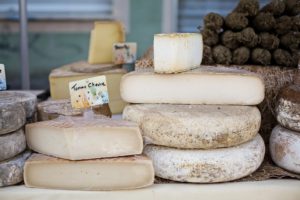Cheese is a revered food in France, with the French eating more cheese each year than any other nationality in the world. It’s a vast industry, which serves as one of the country’s biggest exports. Along with wine, bread, and pastries, cheese is also an integral part of French history, culture, and tradition. It is often enjoyed while sipping coffee from a french press coffee maker. While French cheese’s exact origin is shrouded in history and only believed to be brought by a “good accident,” it has evolved immensely through time, resulting in different variations, yet always has been a source of national pride.
History of French Cheese
Cheese history is linked to the world’s civilization evolution. During the New Stone Age, there was a surplus in the milk supply from farm animals. Neolithic people placed their milk in potteries but since there was no means of refrigeration, people were not able to enjoy it that long with milk turning sour and spoiling quickly. Yet, legends say that the cheesemaking may have most likely begun by accident or experiment with spoiled milk.
Production of cheese was developed further during the Middle Ages with the discovery of rennet, an enzyme that allowed the process of cheese curdling more quickly. In France, French cheese’s rich and delicious tradition blossomed in the monasteries. The monks practiced cheesemaking and took immense pride in their cheese, providing great care and meticulation in its production. Many famous cheese recipes in different regions of France, such as the Maroilles, Tête de Moines, and Munster, were the monks’ great creations.
Monks are also said to have guided farmers on the proper care of their animals and on how to keep their milk clean. With the farmers gaining knowledge on how to appropriately ripen and age milk, cheesemaking started to prosper even more in the country, which led to the establishment of dairy associations in different French regions.
Across the years, various experiments and refinement were made, bringing numerous cheese varieties in France. Distinct vegetation and climate from different regions also became a factor in giving each type of cheese its unique flavor. For instance, Camembert and Brie cheese originates from the northern regions of the country, the south is the source of Roquefort cheese, while the west produces the majority of goat cheese.
In the 19th century, renowned French biologist Louis Pasteur discovered microbial fermentation and pasteurization, which paved the way for the modernization of production methods, and allowed the longer preservation of cheese.
Today, cheese producers are now bestowed “The Appellation d’Origine Contrôlée” (AOC), which serves as a guarantee that the product is made in the locality or region and protects its ingredients and style. Seeing its label on a Camembert implies that the cheese is wholly made from Normandy, and if any cheesemaker would like to produce the said cheese, they have to move to the said region.
As such, many of the cheeses with AOC are widely-famous among cheese enthusiasts and are highly-valued by connoisseurs. Here’s a rundown of the major regions and their signature cheeses:
Auvergne
Auvergne, the historical region in central France, is known for the Bleu d’ Auvergne, a type of blue produced from either pasteurized or raw cow’s milk. It received its AOC status in 1975, and is characterized by a smooth texture, creamy ivory color, with a strong aroma yet boasts a creamy, buttery, salty, peppery, spicy, and pungent taste. Bleu d’ Auvergne is perfect for sweet dessert wines and often used in pasta or salad dressings.
Bourgogne
Located in east-central France, Bourgogne is renowned for the Epoisses, a soft-paste cheese made from cow’s milk, which is washed rind and smear-ripened. It possesses a creamy and salty flavor, and pungent smell, best accompanied by white wine and raisin bread.
Franche Comte
The eastern region of Franche Comte produces Comte cheese, the highest produced cheese with AOC status, at around 66,500 tonnes annually. It is produced from the milk of pasture-fed cows with a caramelized and nutty taste, which can be used for cooking or ideal as an appetizer.
Normandie
Normandie is the producer of Camembert, which is arguably the most famous French cheese not only in France but worldwide. It is usually made with raw milk, though there are versions from the region that uses pasteurized milk. A soft, moist cheese, the Camembert has a milky, creamy, and sweet flavor that goes great with fruit, nuts, or a Baguette bread plus a glass of cider or red wine.
Aquitaine
A French region deemed to have some of the country’s lushest agricultural land, Aquitaine is popular for the Ossau-Iraty, an ancient Pyrenees cheese made from sheep’s milk. It has a strong, fruity, nutty, and grassy flavor that requires 90 to 180 days of maturation to achieve, best served before or after dinner.
Final Words
France is more than just the Eiffel Tower or the Notre Dame de Paris. Once there, make sure to check out France’s celebrated cheeses, splurge over its thousand varieties, and get a taste of their age-old staple food!


